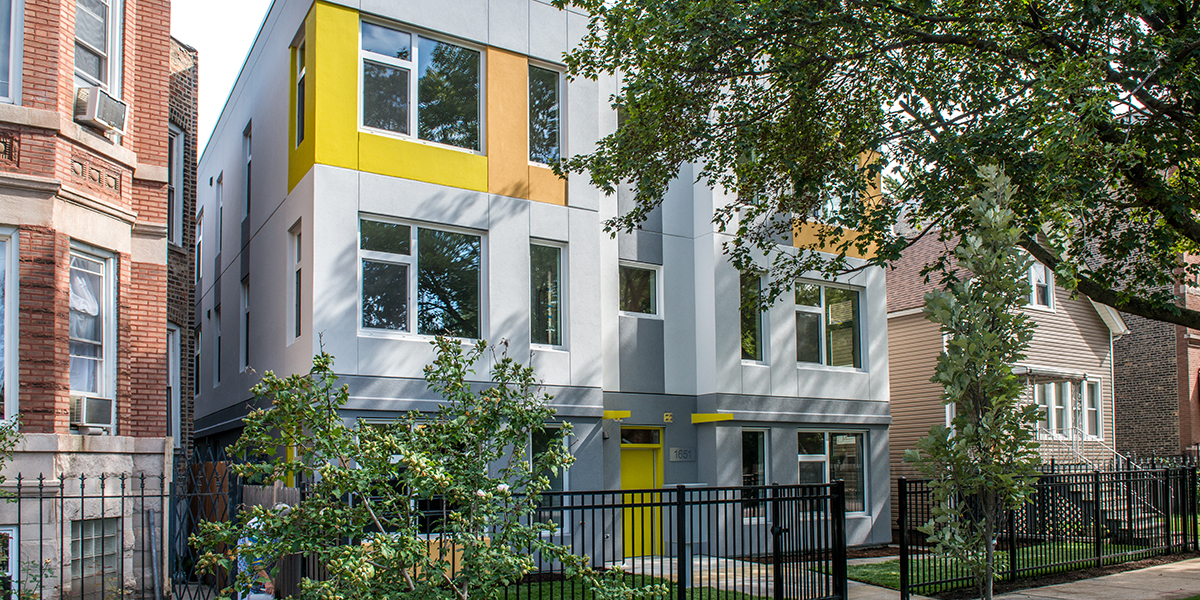
Can Passive House help us build more efficient affordable housing?
As we strive to create a clean energy economy that works for everyone, it's vital that every family has access to housing that’s affordable, resilient, and energy efficient. One place we can make an immediate impact on affordable housing efficiency is in the construction of new properties. For instance, how does the Phius (Passive House Institute U.S.) Certification construction compare to conventional high-performance approaches? To understand the impact, our researchers performed a field study to monitor and evaluate two different Chicago-area six-flat properties to gain valuable insights on the value of passive design.
- The Question: Can a Phius Certified building stack up to the conventional ENERGY STAR standard in new, affordable housing?
- Biggest Takeaway: The Passive House building required 60% less heating energy than a comparable ENERGY STAR building—a sign that it shows promise as an efficient standard for affordable housing new construction.
- What's Next: ComEd will further investigate integration of the Passive House standard as part of its Affordable Housing New Construction offering. In the meantime, more pilots and demonstrations are needed to fully explore the potential of Phius Certification.
In this project, we partnered with the ComEd Energy Efficiency Program to construct a new building as part of the Latin United Community Housing Association (LUCHA)'s Tierra Linda development in Chicago’s Humboldt Park neighborhood. This multi-family property was built to Phius Certification standards, which we compared to a neighboring building constructed to ENERGY STAR standards.
After a year of monitoring—including your typically cold Chicago winter—we discovered that the Passive House standard required 60% less heating energy than the twin ENERGY STAR property. Along with all the other benefits of Phius, from improved indoor air quality to increased comfort, the standard cut overall energy use considerably.
Our team conducted in-depth monitoring of both properties to understand the overall difference in performance and the energy and indoor environmental impacts of discrete elements of the Phius approach. These include insulation levels, window performance, air sealing, heating using air-source heat pumps, ventilation, appliances, and more. By monitoring these different elements, we aimed to gain insights on how these standards might make future affordable housing efficiency programs as effective as possible.
Differences between Passive House and ENERGY STAR
The differences between Passive House and ENERGY STAR mainly comes down to a few factors: insulation, ventilation, and appliances. In particular, the Passive House property included:
- High-performance shell and triple-pane windows. We found evidence that the high-performance windows alone provide almost 30% of the energy savings but account for less than 10% of the incremental cost.
- Electrified heating. The Passive House building used air-source heat pumps to condition the space, compared to ENERGY STAR’s appliances such as gas furnaces. While this leads to greater energy efficiency, the cost can vary widely depending on factors such as utility rates.
- Energy recovery ventilators (ERVs). The Passive House building incorporated ERVs, which provided balanced ventilation but were less reliable in very cold weather—a factor that might require further study.
Aside from the building standards, the two buildings were nearly identical, making them an ideal test case for comparing the two standards side by side.
Chicago was an ideal site for such as a study, as its predictably varied climate—hot, humid summers followed by bitter-cold winters—poses a unique challenge to making energy efficient buildings.
The Takeaway
In the end, we found that Passive House shows promise as an efficient option for affordable new construction. Some highlights from the final report include:
- The Passive House building required 60% less heating energy than the ENERGY STAR building, even in a city known for its cold. What’s more, the total site energy use was about one third less for the Passive House building, making it a better overall option for the goal of reducing energy consumption.
- Annual energy costs for the Passive House building are about 19% less than the ENERGY STAR building, mainly due to differences in utility rates
- There are no indications that indoor air quality in the Passive House building is significantly different than in the ENERGY STAR building. In fact, the relative humidity in winter is somewhat higher under Passive House, a quality that is important for occupant comfort.
- Passive House is a greener option. Greenhouse gas emissions were a quarter to a third less than those of the ENERGY STAR property. At Slipstream, we have reason to believe that an all-electric version of Passive House could achieve even lower emissions.
Ultimately, the Passive House standard and certification provides design teams with a roadmap to achieve significant performance improvements beyond the conventional best practices seen in the ENERGY STAR multi-family building certification. Based on the results of this project, ComEd will further investigate integration of the Passive House standard as part of its Affordable Housing New Construction offering.
For more information, and to read the preliminary results, see the executive summary on the ComEd Customer Innovation website.
In the meantime, as part of our mission to accelerate climate solutions for everyone, Slipstream continues to evaluate new breakthroughs in energy efficiency and how they intersect with health, resilience, and affordability.
To hear the latest news about Slipstream's research, subscribe to The Accelerator here.
Photo of Tierra Linda development courtesy of Gordon Walek
Commonwealth Edison Company (ComEd©) engages in numerous research projects focused on improving energy efficiency opportunities for customers. The above describes one such project. The information is provided only for general awareness. It is not technical guidance and cannot be copied in full or part or reused in any form or manner. It should not be relied upon for any purpose. ComEd makes no representation that its content is correct, accurate, complete, or useful in any manner – including the particular purpose to which it relates – nor does it indicate a commitment by ComEd to any future course of action.